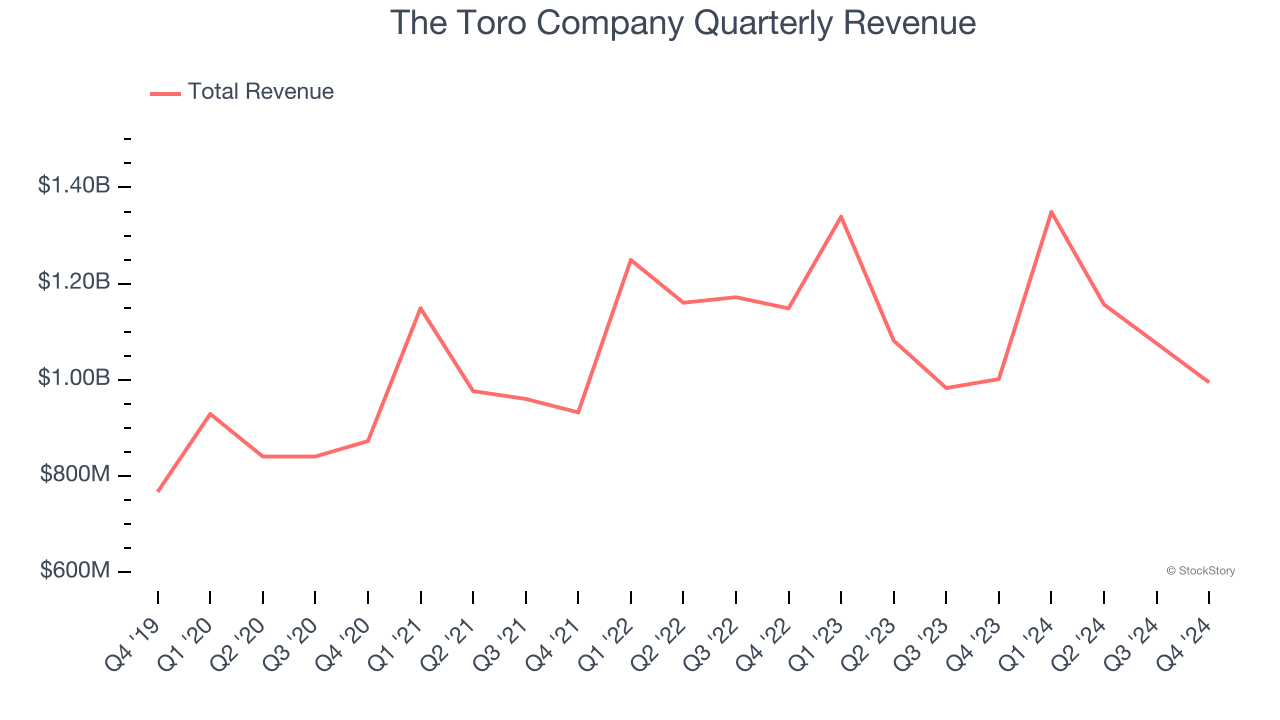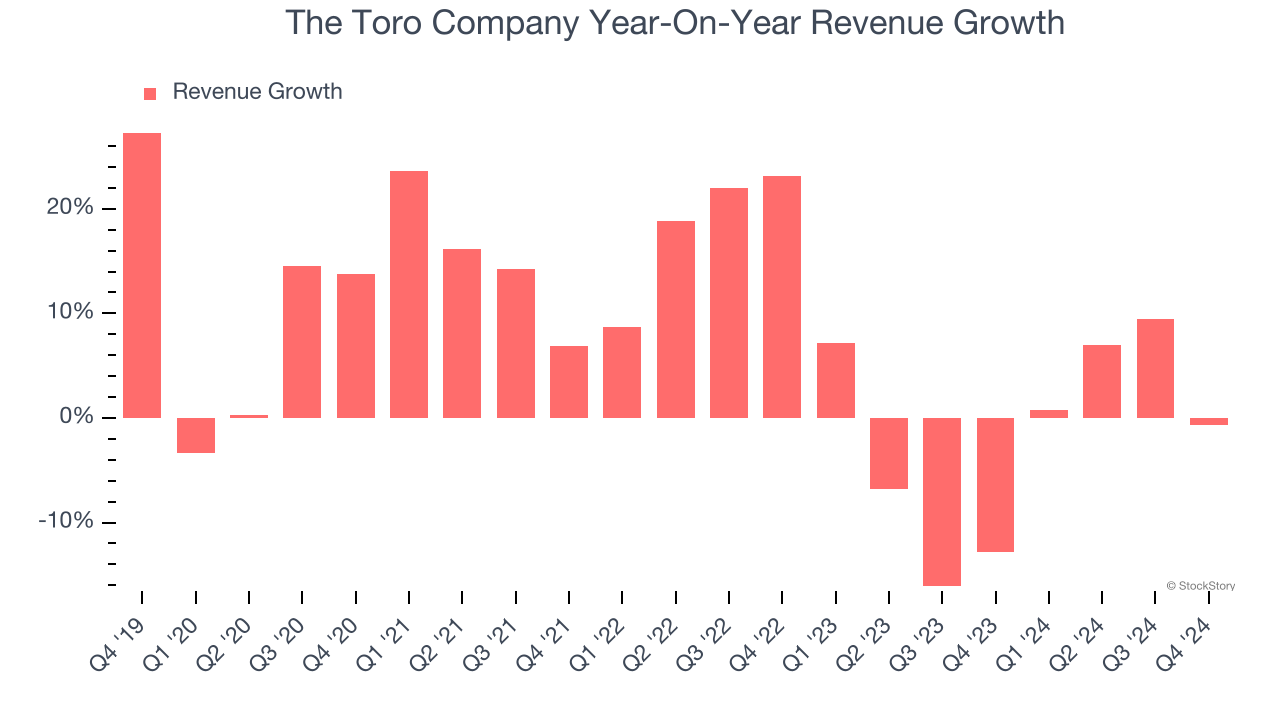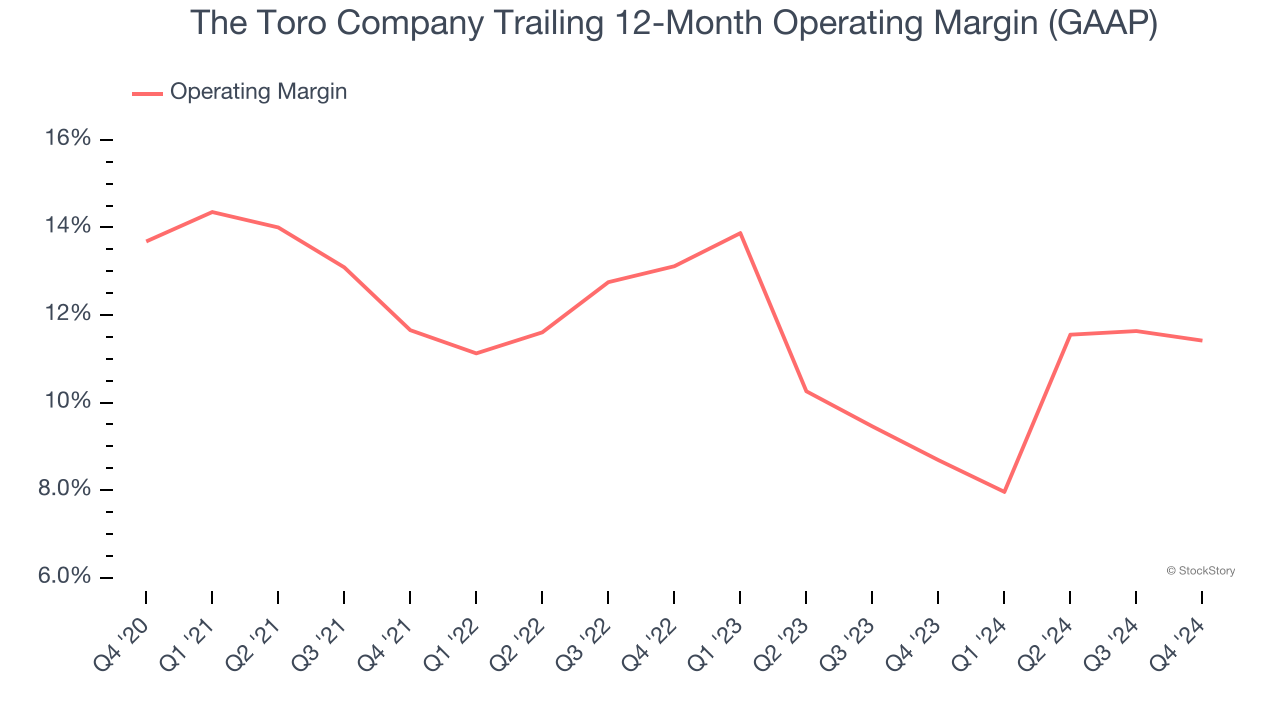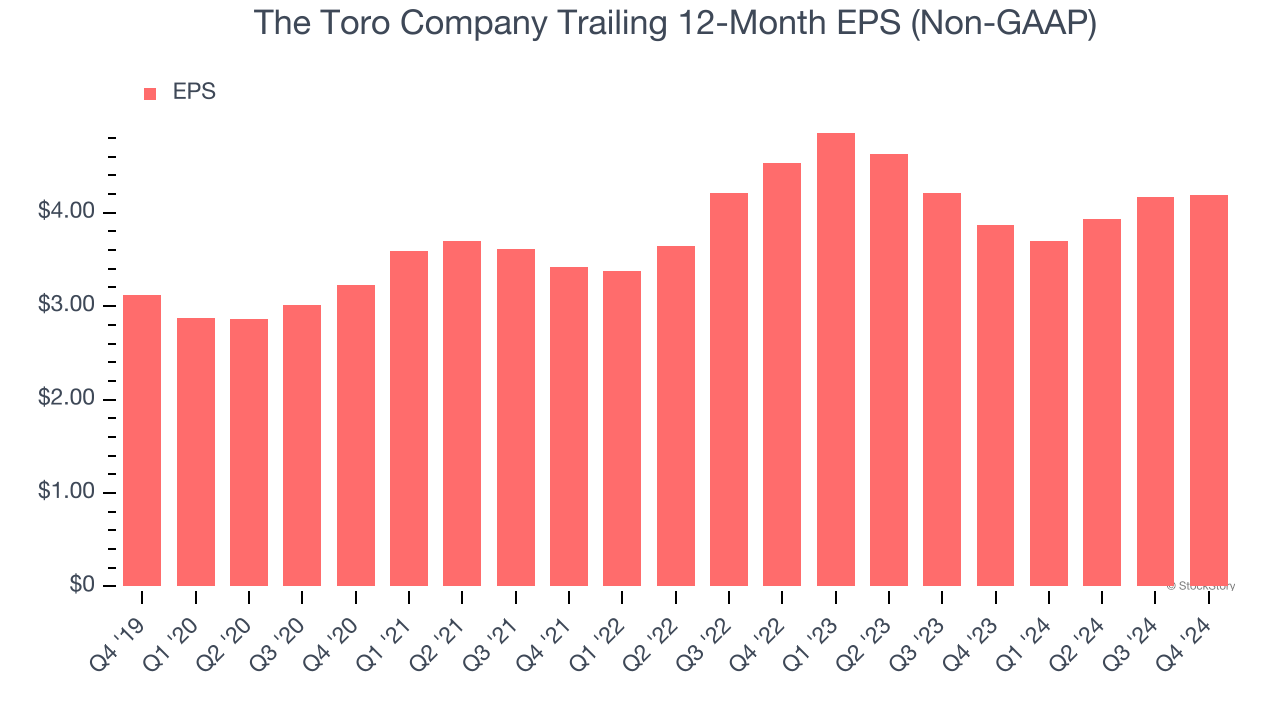The Toro Company (NYSE:TTC) Reports Sales Below Analyst Estimates In Q4 Earnings

Outdoor equipment company Toro (NYSE: TTC) missed Wall Street’s revenue expectations in Q4 CY2024, with sales flat year on year at $995 million. Its non-GAAP profit of $0.65 per share was 3.6% above analysts’ consensus estimates.
Is now the time to buy The Toro Company? Find out by accessing our full research report, it’s free.
The Toro Company (TTC) Q4 CY2024 Highlights:
- Revenue: $995 million vs analyst estimates of $1 billion (flat year on year, 1% miss)
- Adjusted EPS: $0.65 vs analyst estimates of $0.63 (3.6% beat)
- Adjusted EBITDA: $106.4 million vs analyst estimates of $124.3 million (10.7% margin, 14.4% miss)
- Management reiterated its full-year Adjusted EPS guidance of $4.33 at the midpoint
- Operating Margin: 7.8%, down from 8.8% in the same quarter last year
- Free Cash Flow was -$67.7 million compared to -$111.3 million in the same quarter last year
- Market Capitalization: $7.85 billion
Company Overview
Ceasing all production to support the war effort during World War II, Toro (NYSE: TTC) offers outdoor equipment for residential, commercial, and agricultural use.
Agricultural Machinery
Agricultural machinery companies are investing to develop and produce more precise machinery, automated systems, and connected equipment that collects analyzable data to help farmers and other customers improve yields and increase efficiency. On the other hand, agriculture is seasonal and natural disasters or bad weather can impact the entire industry. Additionally, macroeconomic factors such as commodity prices or changes in interest rates–which dictate the willingness of these companies or their customers to invest–can impact demand for agricultural machinery.
Sales Growth
Examining a company’s long-term performance can provide clues about its quality. Any business can put up a good quarter or two, but the best consistently grow over the long haul. Unfortunately, The Toro Company’s 6.7% annualized revenue growth over the last five years was mediocre. This was below our standard for the industrials sector and is a tough starting point for our analysis.

We at StockStory place the most emphasis on long-term growth, but within industrials, a half-decade historical view may miss cycles, industry trends, or a company capitalizing on catalysts such as a new contract win or a successful product line. The Toro Company’s performance shows it grew in the past but relinquished its gains over the last two years, as its revenue fell by 1.6% annually. 
We can dig further into the company’s revenue dynamics by analyzing its most important segments, Professional and Residential , which are 77.3% and 22.2% of revenue. Over the last two years, The Toro Company’s Professional revenue (sales to contractors) was flat while its Residential revenue (sales to homeowners) averaged 2.4% year-on-year declines.
This quarter, The Toro Company missed Wall Street’s estimates and reported a rather uninspiring 0.7% year-on-year revenue decline, generating $995 million of revenue.
Looking ahead, sell-side analysts expect revenue to grow 1.9% over the next 12 months. Although this projection implies its newer products and services will catalyze better top-line performance, it is still below average for the sector.
Unless you’ve been living under a rock, it should be obvious by now that generative AI is going to have a huge impact on how large corporations do business. While Nvidia and AMD are trading close to all-time highs, we prefer a lesser-known (but still profitable) stock benefiting from the rise of AI. Click here to access our free report one of our favorites growth stories.
Operating Margin
Operating margin is one of the best measures of profitability because it tells us how much money a company takes home after procuring and manufacturing its products, marketing and selling those products, and most importantly, keeping them relevant through research and development.
The Toro Company has managed its cost base well over the last five years. It demonstrated solid profitability for an industrials business, producing an average operating margin of 11.6%. This result isn’t too surprising as its gross margin gives it a favorable starting point.
Looking at the trend in its profitability, The Toro Company’s operating margin decreased by 2.3 percentage points over the last five years. This raises questions about the company’s expense base because its revenue growth should have given it leverage on its fixed costs, resulting in better economies of scale and profitability.

In Q4, The Toro Company generated an operating profit margin of 7.8%, down 1 percentage points year on year. Since The Toro Company’s operating margin decreased more than its gross margin, we can assume it was recently less efficient because expenses such as marketing, R&D, and administrative overhead increased.
Earnings Per Share
Revenue trends explain a company’s historical growth, but the long-term change in earnings per share (EPS) points to the profitability of that growth – for example, a company could inflate its sales through excessive spending on advertising and promotions.
The Toro Company’s unimpressive 6.1% annual EPS growth over the last five years aligns with its revenue performance. This tells us it maintained its per-share profitability as it expanded.

Like with revenue, we analyze EPS over a shorter period to see if we are missing a change in the business.
The Toro Company’s two-year annual EPS declines of 3.9% were bad and lower than its two-year revenue performance.
In Q4, The Toro Company reported EPS at $0.65, up from $0.64 in the same quarter last year. This print beat analysts’ estimates by 3.6%. Over the next 12 months, Wall Street expects The Toro Company’s full-year EPS of $4.18 to grow 6.6%.
Key Takeaways from The Toro Company’s Q4 Results
It was encouraging to see The Toro Company beat analysts’ EPS expectations this quarter. On the other hand, its EBITDA missed significantly and its revenue fell slightly short of Wall Street’s estimates. Overall, this was a weaker quarter. The stock traded down 1.4% to $77 immediately following the results.
The latest quarter from The Toro Company’s wasn’t that good. One earnings report doesn’t define a company’s quality, though, so let’s explore whether the stock is a buy at the current price. The latest quarter does matter, but not nearly as much as longer-term fundamentals and valuation, when deciding if the stock is a buy. We cover that in our actionable full research report which you can read here, it’s free.
More News
View More




Recent Quotes
View More
Quotes delayed at least 20 minutes.
By accessing this page, you agree to the Privacy Policy and Terms Of Service.